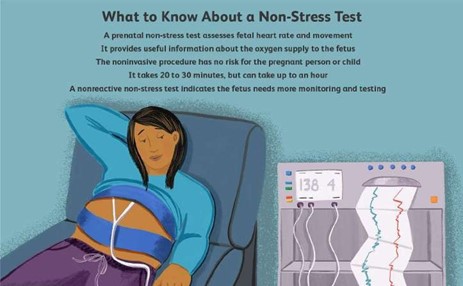A nurse is assessing the results of a nonstress test for an antepartum client at 35 weeks of gestation. Which of the following findings should indicate to the nurse the need for further diagnostic testing?
Three fetal movements perceived by the client in a 20 min testing period
No late decelerations in the foetal heart rate noted with three uterine contractions of 60 seconds in duration within a 10-min resting period
An increase in foetal heart rate to 150/min above the baseline of 140/min lasting 10 seconds in response to foetal movement within a 40-min testing period
Irregular contractions of 10 to 20 seconds in duration that are not felt by the client
The Correct Answer is A
A nonstress test measures fetal heart rate in response to fetal movement. A reactive nonstress test result is when there are at least two accelerations of the fetal heart rate within a 20-minute period, each lasting at least 15 seconds and peaking at least 15 beats per minute above the baseline. If there are fewer than two accelerations within a 20-minute period, further diagnostic testing may be needed.

Nursing Test Bank
Naxlex Comprehensive Predictor Exams
Related Questions
Correct Answer is D
Explanation
A) Hypertension is not typically an adverse reaction to magnesium sulfate; this medication is actually used to lower high blood pressure in preeclampsia.
B) Hypoglycemia is also not a common adverse reaction to magnesium sulfate. This medication does not typically affect blood sugar levels.
C) A respiratory rate of 16/min is within normal limits and is not indicative of an adverse reaction to magnesium sulfate, which can cause respiratory depression if it does affect breathing.
D) Urine output of 20 mL/hr is a concerning sign and can indicate nephrotoxicity or acute kidney injury, which are possible adverse reactions to magnesium sulfate, especially in the context of preeclampsia where kidney function must be closely monitored.
Correct Answer is A
Explanation
Hypovolemic shock occurs when there is a significant decrease in the circulating blood volume, which can happen after severe bleeding during childbirth. The body tries to compensate for this decrease in blood volume by constricting blood vessels and increasing heart rate. However, these compensatory mechanisms can only last for a certain amount of time before the body starts to show signs of shock.
One of the hallmark signs of hypovolemic shock is cool, clammy skin, which is caused by the body diverting blood flow away from the skin to maintain perfusion to vital organs. Other common signs and symptoms include tachycardia (fast heart rate), hypotension (low blood pressure), tachypnea (fast breathing rate), decreased urine output, and altered mental status.

Whether you are a student looking to ace your exams or a practicing nurse seeking to enhance your expertise , our nursing education contents will empower you with the confidence and competence to make a difference in the lives of patients and become a respected leader in the healthcare field.
Visit Naxlex, invest in your future and unlock endless possibilities with our unparalleled nursing education contents today
Report Wrong Answer on the Current Question
Do you disagree with the answer? If yes, what is your expected answer? Explain.
Kindly be descriptive with the issue you are facing.
